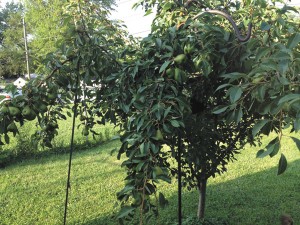The strawberry season this year was disappointing, to say the least. Last year, I joked about having to play “Strawberry Twister” for weeks as I gathered thousands of red ripe strawberries every day from the overgrown patch in the back yard — this year, the berries were fewer and smaller and some strawberry plants simply up and died due to a strange winter and cold spring. The harvest was small, leaving me to figure out what to do to help things along in 2019.
However, the yard hasn’t exactly been fruitless. My pear tree, which I planted over five years ago, is loaded with small pears. This in spite the fact that I lost its twin in a windstorm last year. I was under the impression that pears needed two for cross pollination; the single pear seems to have not gotten that particular memo. Pyrus communis, the common pear, is an easy to grow tree that can produce a lot of fruit if planted in a sunny, well-drained location. However, it is prone to a variety of problems, not the least of which is fire blight, which attacks young leaves and can cause lots of damage.
The much-hated Bradford pear tree bears no fruit and is widely planted as a spring-blossoming ornamental. The flowers actually have a fishy smell and the trees themselves are invasive. They do, however, share one thing in common with the common pear — they are “weak-wooded,” meaning that a strong gust of wind can break them like a toothpick. At my grandfather’s orchard, he had a row of Bartlett and Bosc pears for a time, but replaced them with apples in the mid-70s when they became more trouble than they were worth after a couple of storms. This is often the case with pear trees in orchards, where every tree has to earn its keep, so to speak. The trees become less productive after 10 years or so, even in optimal conditions.
The other issue is that pears are a HEAVY fruit and weigh down branches. I’ve devised an improvised crutch to hold up the branches (see photo), but still the branches bend down. This is particularly annoying when I walk near the tree and get bonked on the head with hard little pears. The squirrels also seem to enjoy climbing up there and picking them, taking a few bites and throwing them to the ground.
Despite the issues, home-grown pears are good eating. I’ve got such a bumper crop I’ve toyed with the notion of getting a home cider mill and making my own perry, a pear hard cider. But that actually sounds like work, which I’m trying my hardest to avoid.
Instead, I think I’ll just sit under the tree and enjoy watching the sparrows and robins fly in and out of the branches. I’ve seen no partridges yet, but I hold out hope.



